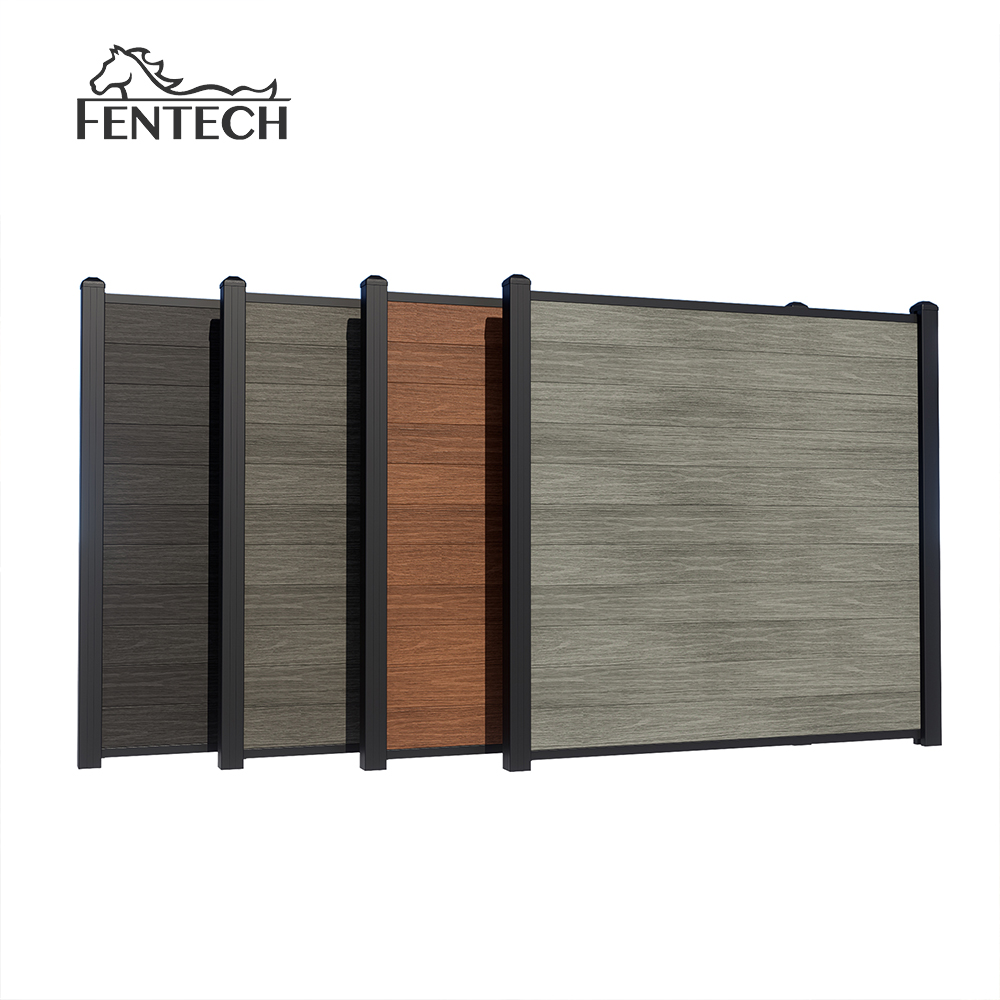We are professional China Custom Vinyl Fence Manufacturers with fences virgin PVC/Vinyl material and UV Protected.
Introduction
When it comes to housing horses, a reliable and secure fence isn't just a suggestion—it's a necessity. A well-constructed fence ensures your horses stay safely contained, protects them from external dangers, and delineates property lines. For horse owners, the choice of fencing material is a critical decision, impacting everything from safety and maintenance to aesthetics and long-term costs. While various materials are available, vinyl horse fence has emerged as a top contender, offering a blend of durability, safety, and visual appeal that makes it an increasingly popular choice.
In this guide, we'll delve into why durable vinyl horse fence is often considered the ideal solution for equestrian properties. We'll explore its unique properties, compare it to traditional fencing options, and highlight the numerous benefits, including why it's consistently praised as safe vinyl fencing for horses. Whether you're setting up a new pasture or upgrading an existing enclosure, understanding the advantages of vinyl fencing is key to making an informed decision for the well-being of your horses and the longevity of your investment.
What is Vinyl Horse Fencing?
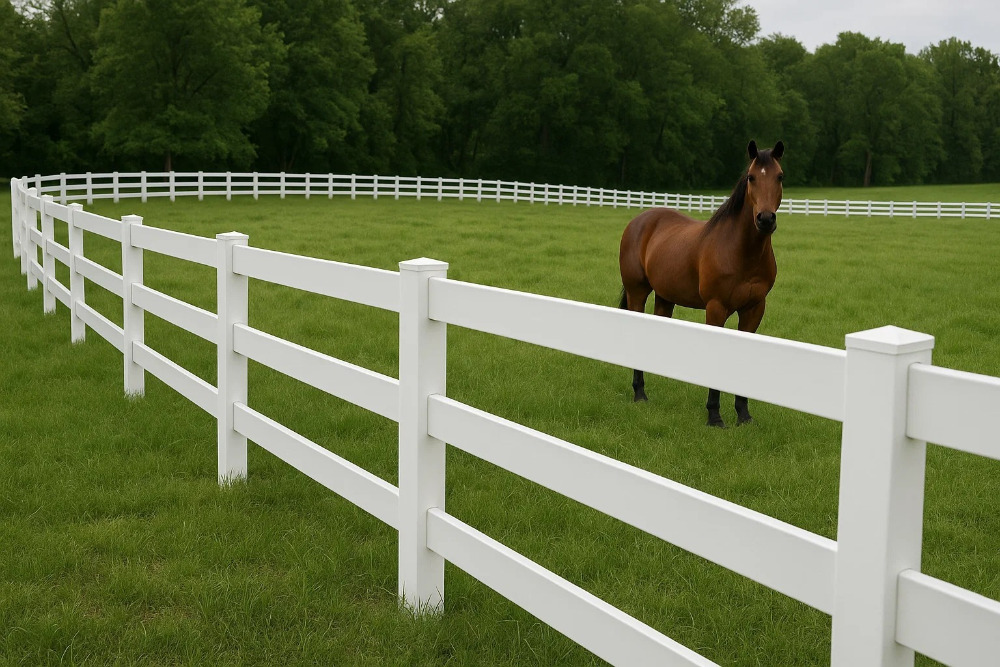
Vinyl horse fencing, often referred to as PVC horse fence, is a type of fencing material made primarily from polyvinyl chloride (PVC). Unlike traditional wood fences that are milled from timber, vinyl fencing is manufactured through an extrusion process where PVC compounds are heated and pushed through a die to create various profiles, such as posts, rails, and pickets. These profiles are then assembled to form sturdy and aesthetically pleasing fence systems.
The composition of vinyl fencing includes specific additives that enhance its durability and performance. These additives provide UV resistance to prevent fading and degradation from sun exposure, impact modifiers to increase strength and flexibility, and stabilizers to ensure the material maintains its integrity over time. This engineered composition gives vinyl fencing distinct advantages over other materials.
Comparison with Other Fencing Options
Understanding vinyl's unique qualities becomes clearer when we compare it to other common horse fencing materials:
Durability and Maintenance: Wood fences are classic but demand significant upkeep. They require regular painting, staining, or sealing to prevent rot, warping, and insect damage. Even with diligent maintenance, wood can splinter, crack, and eventually succumb to the elements. In contrast, vinyl horse fence is virtually maintenance-free horse fencing. It doesn't rot, splinter, or warp, and it never needs painting.
Safety: While wood can be strong, splinters and jagged edges can pose risks to horses. Horses can also chew on wooden fences, leading to damage and potential ingestion of wood. Vinyl, being a smooth, non-porous material, is inherently safer. It's also largely chew-proof horse fence, significantly reducing the risk of injuries from splintering or ingestion.
Lifespan: The lifespan of a wood fence is highly dependent on climate, wood type, and maintenance, typically ranging from 10 to 20 years. Vinyl fencing, however, is designed for exceptional longevity, often lasting 20 to 30 years or even longer, making it an excellent long-term investment.
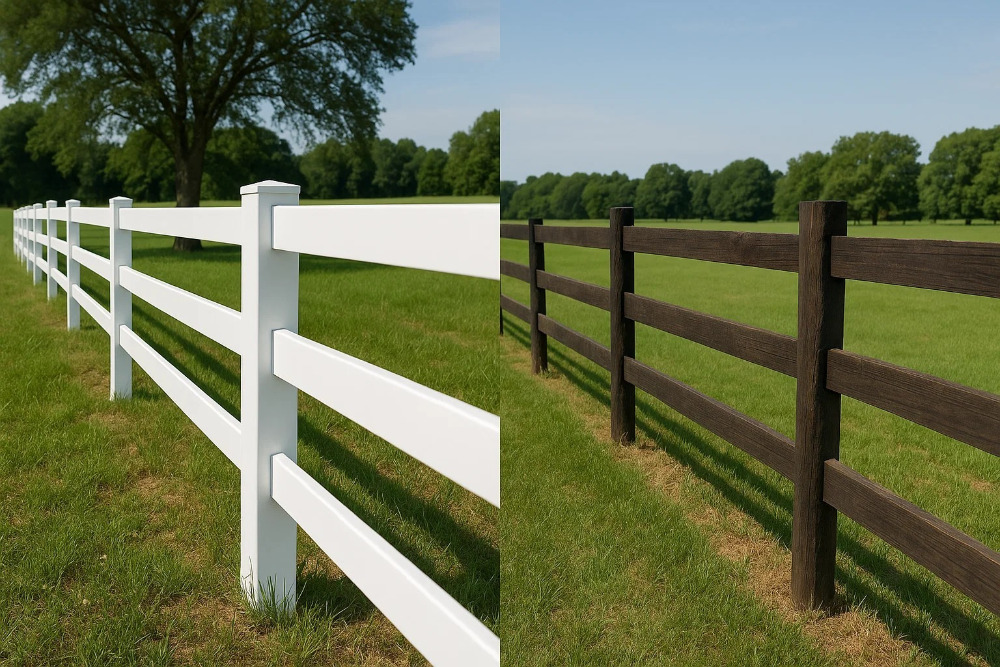
Vinyl vs. Electric Horse Fence:
Containment Method: Electric fences rely on a mild electric shock to deter horses from leaning on or crossing the boundary. While effective for containment, they require a power source and regular checks to ensure the charge is consistent. Vinyl fencing, on the other hand, provides a physical barrier.
Visibility and Aesthetics: Electric fences often consist of thin wires, which can be less visible, especially to fast-moving animals. They also offer minimal aesthetic appeal. White vinyl horse fencing and other colored options provide a highly visible and attractive boundary that enhances the look of your property.
Safety: While generally safe, an electric fence malfunction could lead to a loss of containment or, in rare cases, a more severe shock if an animal becomes entangled. Vinyl provides a constant, reliable physical barrier without the need for electricity.
Cost and Installation: Initial installation of a basic electric fence can sometimes be cheaper than vinyl. However, electric fences incur ongoing electricity costs and may require more frequent component replacement. Vinyl has a higher upfront cost but offers significant savings on long-term maintenance and replacement.
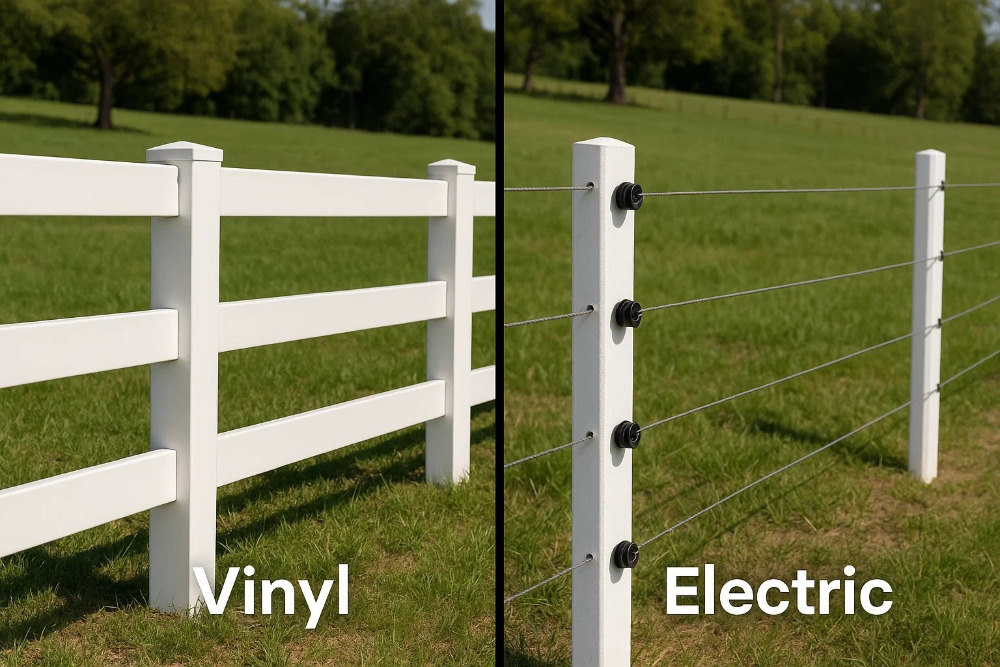
Vinyl vs. Wire Mesh/Woven Wire Fences:
Safety: While wire fences can be effective, smaller mesh sizes can potentially snag hooves, and larger openings could allow a horse to get a leg caught. Rust and sharp points can also be a concern. Vinyl fencing presents a solid, smooth surface with no sharp edges or potential snag points.
Visibility: Wire fences are less visible than vinyl, which can be an issue for horses, especially those new to an enclosure. The clear visibility of vinyl helps horses recognize and respect the boundary.
Durability: Wire can rust and sag over time, requiring tensioning and repair. Vinyl maintains its structure and appearance without these common issues.
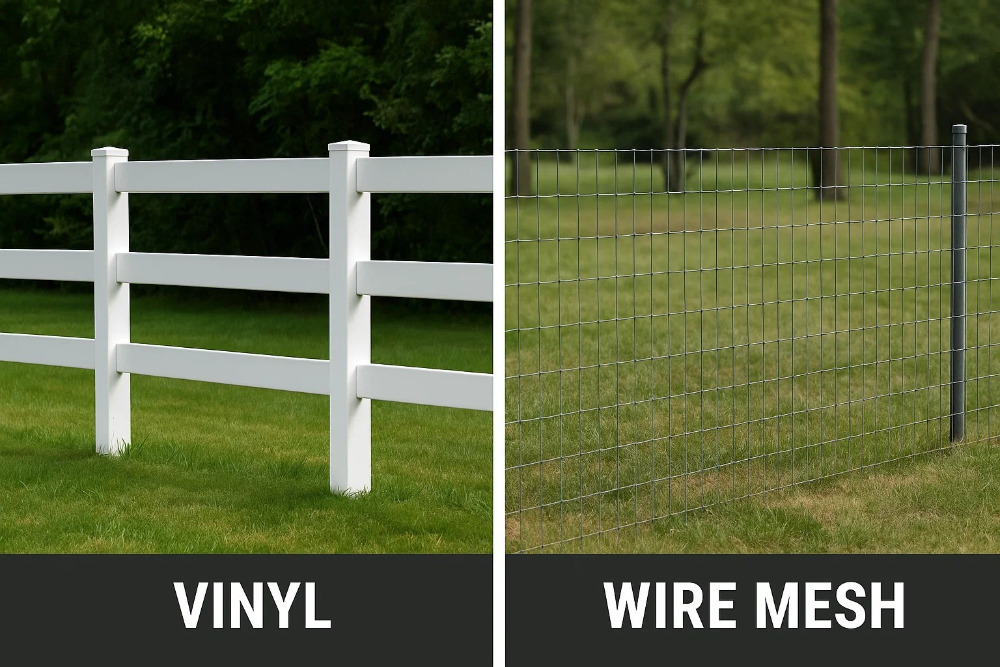
Benefits of Vinyl Horse Fencing
Choosing vinyl horse fencing offers a wealth of advantages that make it a superior option for many equestrians. These benefits translate into long-term savings, reduced effort, and enhanced safety for your horses.
Durability: Weatherproof and Longest Lasting
One of the most compelling reasons to choose vinyl is its exceptional durability. Unlike wood, which is susceptible to rot, decay, and insect infestation, vinyl is impervious to these issues. It's engineered to withstand a wide range of environmental conditions, making it truly weatherproof horse fencing.
Resistance to Elements: Vinyl fencing will not warp, splinter, or crack due to sun exposure, extreme temperatures, or moisture. It resists fading thanks to UV inhibitors in its composition, maintaining its vibrant appearance for decades.
Impact Resistance: High-quality vinyl is designed with impact modifiers that give it flexibility and strength, allowing it to withstand bumps and knocks from horses without breaking or deforming.
Longevity: With proper installation, vinyl horse fence is renowned for being the longest lasting horse fencing solution available. Many manufacturers offer substantial warranties, often 20 years or more, attesting to its extended lifespan. This significantly reduces the need for frequent repairs or costly full replacements, offering excellent long-term value.
Low Maintenance: Virtually Maintenance-Free
The "set it and forget it" nature of vinyl fencing is a dream for busy horse owners. While other fencing materials demand constant attention, vinyl requires very little.
No Painting or Staining: Vinyl's color is integrated throughout the material, meaning it never needs painting, staining, or sealing. This eliminates a significant and recurring chore.
No Rotting or Rusting: Being a synthetic material, vinyl is immune to the rot and decay that plague wood fences and the rust that can affect metal fences.
Easy Cleaning: For the most part, rain will keep your vinyl fence relatively clean. If it does get dirty, a simple rinse with a garden hose, or a gentle scrub with soap and water for tougher stains, is usually all that's needed. This makes it truly maintenance-free horse fencing.
Safety: Chew-Proof and Injury Resistant
Horse safety is paramount, and vinyl fencing excels in this regard. Its design and material properties significantly reduce the risk of injury.
Chew-Proof: Horses have a natural tendency to chew on wooden fences, leading to splinters, ingestion of wood, and damage to the fence itself. Vinyl is specifically designed to be a chew-proof horse fence. Its smooth, unpalatable surface discourages chewing, protecting both the fence and your horses.
No Splinters or Sharp Edges: Unlike wood, vinyl does not splinter, crack, or develop sharp edges that can injure horses. The smooth surface minimizes the risk of cuts, abrasions, or puncture wounds.
Breakaway Design (in some systems): While strong, some vinyl fence systems are designed to flex or even break away under extreme pressure (e.g., a horse running into it at high speed). This can be a critical safety feature, as it allows the fence to absorb impact or give way rather than causing severe injury to the animal. This contributes significantly to its reputation as safe vinyl fencing for horses.
Aesthetics: Clean, Uniform, and Versatile
Beyond its practical benefits, vinyl horse fencing offers a clean, attractive appearance that enhances the overall look of your property.
Classic White Look: White vinyl horse fencing is particularly popular for its classic, pristine appearance, evoking the timeless beauty of traditional farm fences but without the upkeep. This bright, uniform look maintains its appeal for decades.
Variety of Styles: While white is common, vinyl fencing is available in various styles and even some colors (e.g., tan, black) to complement different architectural styles and landscapes. Its uniform manufacturing ensures a consistent look across your entire property, something difficult to achieve with natural materials.
Enhanced Property Value: The clean lines, durability, and low maintenance of vinyl fencing can significantly boost your property's curb appeal and perceived value.
Here's a table summarizing the key benefits of vinyl horse fencing:
| Feature | Description |
| Durability | Impervious to rot, rust, insects, and decay. Weatherproof horse fencing that resists warping, cracking, and fading. Designed for exceptional longevity, often the longest lasting horse fencing option, with lifespans of 20-30+ years. |
| Low Maintenance | Never needs painting, staining, or sealing. No splintering or rotting. Easy to clean with just water. Virtually maintenance-free horse fencing, saving significant time and labor. |
| Safety | Chew-proof horse fence, preventing ingestion and damage. Smooth, non-porous surface eliminates splinters and sharp edges, making it safe vinyl fencing for horses. Some systems offer breakaway design under extreme impact. |
| Aesthetics | Provides a clean, classic, and uniform look, enhancing property curb appeal. White vinyl horse fencing is especially popular for its pristine appearance. Available in various styles and colors to suit preferences. |
Different Types of Vinyl Horse Fencing
Vinyl horse fencing isn't a one-size-fits-all solution; it comes in several styles, each suited for different applications and aesthetic preferences. The choice often depends on the specific needs of your horses, the layout of your property, and your desired level of containment and visibility.
Panel-Style Fences (Post and Rail)
Panel-style fences, often referred to as post and rail vinyl fencing, are the most classic and widely recognized type of horse fence. They consist of vertical posts and horizontal rails that connect them.
Structure: Typically feature 2, 3, or 4 horizontal rails running between vertical posts. The number of rails impacts both the visual density and the level of containment. More rails generally mean greater security for smaller horses or foals.
Appearance: This style offers the iconic look of traditional farm fencing, especially in white vinyl horse fencing, which provides a crisp, clean aesthetic.
Visibility: The open design provides excellent visibility for horses and allows for clear views of the surrounding landscape.
Applications: Ideal for defining large pastures, property boundaries, and general horse containment where aesthetics and clear sightlines are important.
Ranch Fencing (Wider Rails)
Vinyl ranch fencing for horses is a variation of the post and rail system, distinguished by wider, often thicker, horizontal rails.
Structure: Similar to panel-style, but the rails are designed to be more substantial, creating a bolder and more robust appearance.
Strength: The wider rails often provide increased strength and a more imposing barrier.
Aesthetics: Offers a more substantial and often rustic or grander aesthetic, perfect for larger properties or those seeking a more prominent fence line.
Applications: Commonly used for large acreage, perimeter fencing, or areas where a very strong and highly visible barrier is desired, such as along roadways.
Horse Corral Fencing (Heavy Duty Panels)
Vinyl fence for horse corrals refers to more robust and often taller vinyl fencing systems designed for smaller, high-traffic areas where horses are frequently moved, trained, or held for shorter periods.
Structure: Often features closer post spacing, more rails (sometimes 5 or 6), or thicker, reinforced posts and rails to withstand the higher pressure and more concentrated activity of horses in a confined space.
Security: Provides a very secure enclosure, minimizing the risk of horses pushing through or over the fence.
Durability: Built to endure more wear and tear than typical pasture fencing.
Applications: Perfect for round pens, riding arenas, holding pens, turnouts, and small paddocks where extra strength and security are paramount.
| Type of Vinyl Horse Fence | Description | Typical Rail Count | Ideal Applications | Key Features |
| Panel-Style Fence | Classic post and rail design with standard-sized horizontal rails. The most common and visually appealing type for large areas. | 2, 3, or 4 | Large pastures, property boundaries, general horse containment. | Iconic look, excellent visibility, cost-effective for large spans. |
| Ranch Fencing | A variation with significantly wider and often thicker horizontal rails, creating a more substantial and robust appearance. Also known as "board" style. | 2, 3, or 4 | Large acreage, perimeter fencing, high-visibility areas, grand estates. | Bolder aesthetic, enhanced strength, more imposing barrier. |
| Horse Corral Fencing | Heavy-duty systems designed for high-traffic, confined areas, featuring closer post spacing and/or reinforced components. | 3, 4, 5, or 6+ | Round pens, riding arenas, holding pens, small paddocks, turnouts. | Maximum security, built for intense wear, withstands higher pressure. |
How to Install Vinyl Horse Fence
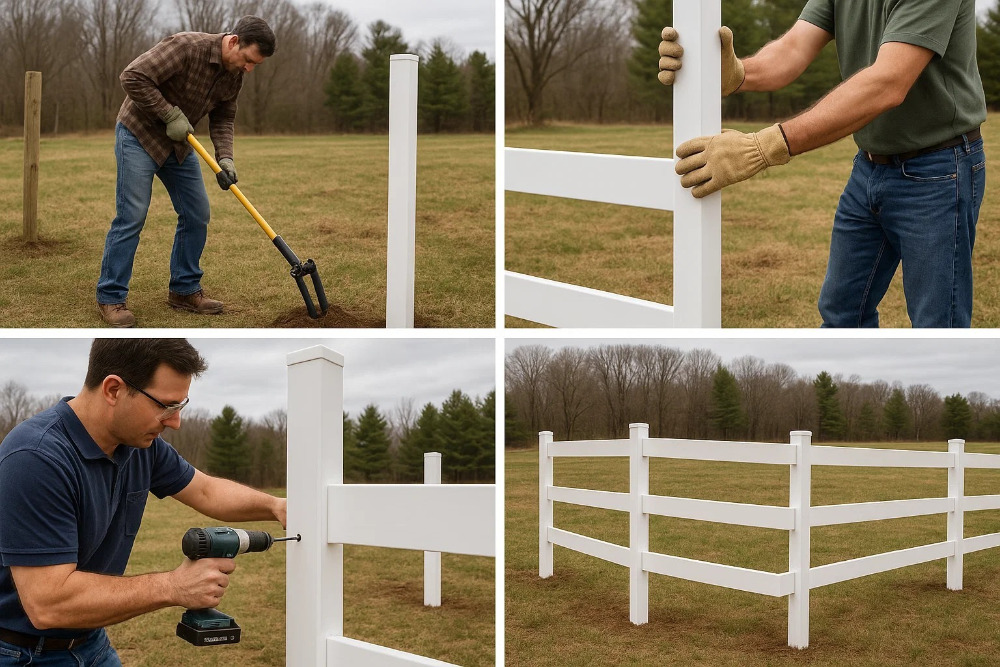
Installing vinyl horse fence is a manageable project, especially with the right preparation and tools. While professional installation is always an option, many DIY enthusiasts find it a rewarding undertaking. Understanding the key steps and considerations is crucial for a successful and durable fence.
DIY Installation
Many manufacturers offer DIY vinyl horse fence kits that come with pre-routed posts and pre-cut rails, simplifying the assembly process. Even without a kit, the general steps remain consistent. Here's a simplified overview of how to install vinyl horse fence:
Plan and Layout:
Measure Your Area: Accurately measure the perimeter of your fencing project to determine the amount of materials needed.
Mark the Fence Line: Use string lines and stakes to clearly mark the entire fence path. This ensures a straight and consistent fence.
Identify Post Locations: Mark the precise locations for each fence post, taking into account post spacing (discussed below).
Dig Post Holes:
Depth and Diameter: Holes should be deep enough to secure the post against frost heave and strong winds—typically one-third to one-half the length of the post. The diameter should be at least three times the width of the post.
Tools: A post-hole digger, auger (manual or powered), or a mini-excavator can be used depending on the scale of the project and soil conditions.
Set the Posts:
Corner and End Posts First: These are critical for tension and alignment. Set them perfectly plumb (vertically straight) using a level.
Concrete Setting: Most vinyl fence posts are set in concrete for maximum stability. Mix concrete according to manufacturer instructions and pour it into the hole around the post. Ensure the post remains plumb as the concrete sets.
Gravel Base: Some installers prefer a gravel base at the bottom of the hole for drainage before adding concrete, especially in areas with poor drainage.
Install the Rails:
Routing: Vinyl posts come pre-routed with holes or channels for the rails to slide into.
Interlocking System: Rails typically have "tabs" or notched ends that lock securely into the post's routed holes, often without the need for fasteners. This creates a strong, seamless connection.
Leveling: Use a level to ensure each rail is installed perfectly horizontal. Adjust post height slightly if needed before the concrete fully cures.
Add Post Caps:
Once all posts and rails are in place, decorative post caps are typically secured on top of each post, providing a finished look and protecting the post interior.
Install Gates:
Gate Posts: Gate posts require extra reinforcement due to the weight and movement of the gate. They are usually heavier duty and set in larger concrete footings.
Hardware: Attach hinges and latches to the gate and gate posts according to the gate kit instructions. Ensure the gate swings freely and latches securely.
Key Point for PVC horse fence installation: While vinyl is forgiving, precise measurement and ensuring posts are plumb are vital for a professional-looking and strong fence.
Post Spacing
Vinyl horse fence post spacing is a crucial factor that impacts both the strength and cost of your fence.
Typical Spacing: For standard vinyl horse fencing, common post spacing ranges from 6 to 10 feet.
Factors Influencing Spacing:
Rail Length: The length of the vinyl rails you purchase will dictate your maximum post spacing. Most rails come in 8-foot or 16-foot lengths, which can be cut down.
Fence Height: Taller fences may require slightly closer post spacing for added stability, especially in windy areas.
Wind Load: In areas prone to high winds, reducing post spacing can significantly improve the fence's ability to withstand pressure.
Terrain: Uneven terrain may necessitate adjustments to post spacing to maintain consistent rail height and appearance.
Desired Strength: For high-traffic areas or corrals where horses might lean or push more, closer post spacing will provide a more robust barrier.
Always check the manufacturer's recommendations for post spacing specific to the vinyl fencing system you choose, as this can vary.
Fence Gate Options
Choosing the right gate for your vinyl horse fence is essential for functionality, security, and aesthetics.
Matching Design: Vinyl gates are designed to perfectly match the style and color of your chosen fence, ensuring a seamless and attractive entry point.
Single Swing Gates: Ideal for pedestrian access or smaller openings, allowing one panel to swing open.
Double Swing Gates (Drive-Through Gates): Comprised of two gate panels that meet in the middle, perfect for wide openings needed for vehicles, tractors, or horse trailers.
Gate Latches and Hinges:
Heavy-Duty Hardware: Due to the weight and constant use, vinyl gates require robust, rust-resistant hardware, often made of powder-coated steel or aluminum.
Self-Latching Mechanisms: For safety and convenience, many horse gates feature self-latching mechanisms, ensuring the gate closes securely behind you.
Two-Way Hinges: Some hinges allow the gate to swing both inward and outward, offering flexibility.
Reinforced Gate Posts: Gate posts are subject to more stress than line posts and should always be reinforced, often with internal aluminum inserts or larger concrete footings, to prevent sagging over time.
Careful planning of gate locations and proper installation of gate posts and hardware are key to a long-lasting and functional fence system.
Cost Analysis
When considering any major investment for your property, especially one as significant as horse fencing, understanding the cost is crucial. While the upfront price of vinyl horse fencing might seem higher per foot than some traditional materials, a comprehensive cost analysis reveals its significant long-term value and return on investment.
Cost Per Foot
The vinyl horse fence cost per foot can vary widely based on several factors:
Type and Style: As discussed earlier, a 2-rail ranch style fence will generally be less expensive per foot than a 4-rail or 5-rail panel-style fence, and heavy-duty corral fencing will likely be at the higher end of the spectrum due to more material and stronger components.
Height: Taller fences require more material per post and rail, increasing the cost.
Quality and Manufacturer: Like any product, there are different grades of vinyl fencing. Higher-quality vinyl with enhanced UV inhibitors and impact modifiers might have a higher initial cost but offers superior durability and longevity. Reputable manufacturers may also have slightly higher prices but typically provide better warranties and support.
Geographic Location: Material and labor costs can vary significantly by region.
Installation Method: DIY installation will save on labor costs, but you'll need to factor in tool rental (if necessary) and your own time. Professional installation will add a significant labor component to the total cost.
Accessories: Gates, specialized end posts, corner posts, and decorative post caps can all add to the overall price.
As a general estimate, vinyl horse fence cost per foot can range from approximately $15 to $40 or more per linear foot, excluding installation for basic styles, and potentially higher for more complex or heavy-duty systems. This figure usually includes the posts, rails, and basic hardware.
Long-Term Investment Return (Compared to Wood or Wire)
While the initial outlay for vinyl fencing might be greater than for wood or basic wire fences, the true cost becomes apparent when you consider the lifespan and maintenance requirements. This is where vinyl truly shines as a sound long-term investment.
No Ongoing Maintenance Costs: This is the most significant saving. Wood fences require regular expenses for:
Painting/Staining: Every few years, representing significant material and labor costs.
Repairs: Replacing rotted posts, broken rails, and splintered boards.
Pest Control: Treating for termites or other wood-boring insects.
Cleaning: While vinyl might need occasional washing, wood often requires more intensive cleaning to prevent mold and mildew.
In contrast, vinyl fences incur virtually no such ongoing expenses. The savings on paint, stain, brushes, repair materials, and labor quickly add up over two decades.
Extended Lifespan: Vinyl fences typically last 20-30 years or even longer. Wood fences, even well-maintained ones, often need significant repairs or full replacement every 10-20 years. This means you might replace a wood fence two or three times for every one vinyl fence you install. The cost of multiple fence replacements far outweighs the higher initial investment in vinyl.
Reduced Risk of Injury/Veterinary Bills: While harder to quantify, the superior safety of vinyl fencing (no splinters, chew-proof, less likely to break on impact) can potentially save on costly veterinary bills due to fence-related injuries.
Increased Property Value: The clean, well-maintained appearance of vinyl fencing enhances curb appeal and can contribute positively to your property's resale value, offering a tangible return on investment that decaying wood fences cannot.
Maintenance and Care
One of the most appealing aspects of vinyl horse fencing is its remarkably low maintenance profile. While it's often touted as "maintenance-free," a few simple steps can ensure your fence remains pristine and performs optimally for its extended lifespan.
Cleaning Methods
For the vast majority of vinyl fences, routine cleaning is minimal. The smooth, non-porous surface of PVC naturally resists dirt and grime buildup better than porous materials like wood.
Routine Rinse: In most environments, regular rainfall is often enough to keep your vinyl fence looking clean. For areas that don't receive much rain or for quick touch-ups, a simple rinse with a garden hose is usually sufficient to wash away loose dirt, dust, and pollen.
Mild Soap and Water: For more stubborn dirt, mud splashes, or light mildew growth, a solution of warm water and a mild household detergent (like dish soap) applied with a soft brush or sponge will do the trick. After scrubbing, rinse thoroughly with clean water to remove any soap residue.
Pressure Washing (Use Caution): A pressure washer can be effective for larger areas or tougher stains, but it must be used with extreme caution.
Low Pressure is Key: Always start with the lowest pressure setting and a wide fan tip (e.g., 25-degree or 40-degree) to avoid damaging the vinyl.
Maintain Distance: Hold the nozzle several feet away from the fence and gradually move closer if needed, ensuring you don't direct a concentrated stream at the material.
Avoid Seams: Be especially careful around seams, joints, and caps, as high pressure can force water into the fence's interior, potentially leading to issues.
Removing Tough Stains: For specific stains like rust (from nearby metal, not the vinyl itself), grease, or stubborn mildew, specialized vinyl fence cleaners are available. Always test these products on an inconspicuous area first to ensure they don't discolor or damage the vinyl. Avoid abrasive cleaners, scouring pads, or harsh chemicals like bleach (unless specifically recommended by the manufacturer in a diluted solution), as these can dull the finish or compromise the material.
Checking for Damage (Despite Being Low-Maintenance)
While vinyl horse fencing is incredibly durable and built to last, it's still a good practice to perform occasional checks, especially after severe weather events. This isn't about constant upkeep, but rather proactive care to ensure continued performance and safety.
Post-Storm Inspection: After strong winds, heavy snow, or significant impacts (e.g., a fallen tree branch), walk the fence line. Look for:
Loose Caps: Ensure all post caps are securely in place.
Rail Integrity: Check that all rails are still firmly seated in their post routs and haven't become dislodged or cracked (though cracking is rare).
Post Stability: Gently push on posts to ensure they are still firmly set in the ground and haven't shifted. While rare for well-installed posts, extreme conditions could affect them.
Gate Functionality: Check gate hinges and latches to ensure they are still operating smoothly and securely. Adjust or tighten as needed.
General Visual Scan: Periodically, just take a quick walk along your fence line during your routine checks of your pastures and horses. This helps you spot any minor issues before they become larger problems. Look for any unusual discoloration, chips (extremely rare), or signs of impact.
Addressing Issues Promptly: If you do notice any minor damage, address it quickly. Small cracks can sometimes be repaired with vinyl repair kits, and dislodged rails can often be re-seated. While vinyl fencing is almost maintenance-free horse fencing, prompt attention to rare issues will help maintain its integrity and longevity.
Frequently Asked Questions (FAQs)
Here are answers to some of the most common questions about vinyl horse fencing, addressing concerns and providing clarity for horse owners considering this durable option.
Q: How long does Vinyl fencing last?
A: Vinyl horse fence lifespan is exceptionally long, typically ranging from 20 to 30 years or even longer. This longevity is a key advantage over traditional materials like wood. High-quality vinyl is manufactured with UV inhibitors and impact modifiers that protect it from sun degradation, weathering, and everyday wear and tear. While a wood fence might need significant repairs or replacement every 10-20 years, a properly installed vinyl fence can last for decades with minimal maintenance, often making it a one-time investment for many property owners.
Q: Will horses chew on Vinyl fencing?
A: No, vinyl horse fence is famously chew-proof horse fence. Unlike wood, which horses often gnaw on due to boredom, nutritional deficiencies, or simply habit, vinyl has an unpalatable and smooth surface that does not appeal to horses. This characteristic is a significant safety benefit, as it prevents horses from ingesting wood splinters or chemicals, and it also protects the integrity and appearance of your fence from unsightly bite marks and damage. This eliminates a common problem associated with traditional wooden fences.
Q: Which fence is best for a ranch?
A: For a ranch, vinyl ranch fencing for horses is widely considered an excellent choice due offering a blend of visibility, strength, and low maintenance across expansive areas. The "best" fence depends on specific needs, but vinyl stands out due to:
Visibility: Its often white, clean lines provide excellent visibility, which is crucial for horses, especially at higher speeds or in low light. This helps prevent collisions.
Durability and Longevity: Ranches typically require extensive fencing, and vinyl's resistance to weathering, rot, and pests means less time spent on repairs and more time on managing your livestock and property. It's built to last for decades, even across vast stretches of land.
Low Maintenance: The sheer scale of ranch fencing makes maintenance a daunting task for other materials. Vinyl's virtually maintenance-free nature—no painting, staining, or splintering—translates to massive time and cost savings over the years for ranch owners.
Aesthetics: Vinyl ranch fencing offers a classic, clean aesthetic that complements the open landscapes of a ranch, enhancing its overall appeal.
While electric fencing might be cheaper for temporary or very large, remote areas, and some may prefer the look of natural wood, vinyl ranch fencing for horses offers a superior balance of safety, aesthetics, durability, and minimal upkeep for permanent ranch perimeters and pastures.
Q: Is vinyl fencing good for containing aggressive horses?
A: While vinyl fencing is strong and durable, it's generally best suited for containing horses that respect fence lines. For aggressive horses or those known to challenge fences frequently, supplemental measures might be advisable. This could include adding a single strand of electric wire along the top or inside of the vinyl fence. This provides a psychological deterrent without compromising the aesthetic and physical barrier of the vinyl. The smooth surface of vinyl itself is less likely to cause injury if a horse does impact it, but no fence is 100% horse-proof against a determined or panicked animal. Always consider the individual temperament of your horses when choosing and reinforcing your fencing.
 English
English  中文简体
中文简体












